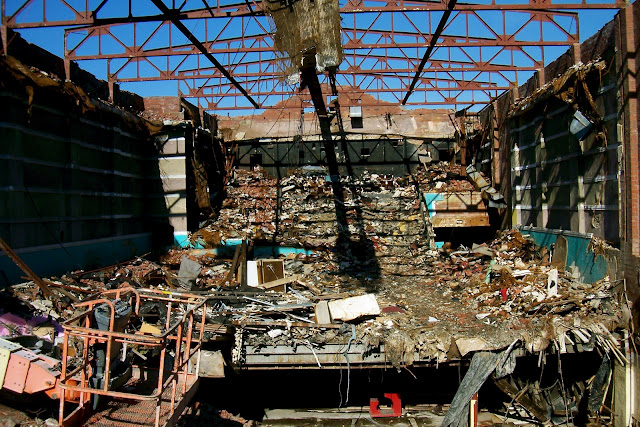 |
| From a calender I bought a few years back |
So it's January 31st, and 63 degrees in SWPA. This is really unheard of. I'm outside on the deck typing this in, it's still so nice out. Anyway, Chip and I decided to get out in this fantastic weather and scope out future exploration sites. Danielle had to work on this fine specimen of a day and we felt truly bad about this, so we went up to Elco PA and had a nice meal and beer at the always scenic High Point bar to make us feel better.
 |
| Wonderful view from the High Point bar |
We decided to leave via California, PA and drove through town and noticed something odd. They were in the process of taking down the old Hollywood Theater. Now, I went to Cal U back in the late 80's and early 90's and I have never remembered this theater to have been open. So did a quick internet search of this place. I found this little description in Cinema Treasures
This theater was opened in July 1938 of concrete block construction, and had a 999 seating capacity, all on a stadium plan. Operated into the late-1960’s with the last regular operater being the Friedlander family. Opened several times for concerts or late night showings on an irregular basis during the early-1970’s.
Last opened late-1970’s for a two year stretch or so. Closed in early-1978, and all seats and equipment removed in the 1980’s. Basement housed a bowling alley which was open to the late-1980’s until being flooded. Attached storefront now a florist shop. Marquee still on building."
"Ulu Grossbard’s STRAIGHT TIME starring Dustin Hoffman was the last film to play. " |
| Borrowed this image from above source, c. 1975 |
Below are a few pictures of the theater coming down.
 |
| Close to 1975 view, but today |
So Chip walked on up to the door and peered through a small opening and quickly declared "lets head around back"! What he noticed while I was snapping pictures, was light seeping through the hole.....A clue to what was around back.
Chip noticed the multicolored 1970's era plastic bowling alley seats in the basement (item described not pictured, sold separately) and was very correct as this being used as a bowling alley once
.
 |
| If you plan a visit, I suggest go quickly! |
Further reading....here, at the Friends Of The Hollywood Theater FB site, but it's a little to late now....




























.jpg)






































































